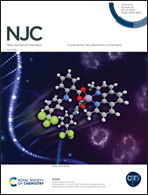Dual-functional organic surfactant for the effective stabilization of nano aluminium†
Abstract
The production of Nano aluminium (Nano-Al) is desirable for research into high-energy materials due to their versatile applications in solid rocket propellants and explosives. The present article features the innovative approach of using the dual functional capping agent 1-aminohexanol (ah) to stabilize Nano-Al produced via the colloidal synthesis process. The obtained product (ah-Al) is highly pure and crystalline with 78.50 ± 1.50% of active aluminium. The average size of ah-Al is around 35 nm in diameter. The structural and morphological properties are investigated using powder X-ray diffraction, scanning electron microscopy, and transmission electron microscopy. These nanoparticles are capped effectively with the organic surfactant, as confirmed by Fourier transform infrared spectroscopy. Thermogravimetric analysis provided insight into the thermal profiles of the organic-coated material during combustion and metal oxidation exotherms. This study reveals that small-length, dual-functional surfactants help to increase the stability by providing complete sealing of the Nano-Al and preventing further atmospheric oxidation. Effective stabilization maintains the stable active aluminium content in the nanoparticles. This work endorses the importance of dual functional surfactants to gain high active aluminium content for energetic applications.



 Please wait while we load your content...
Please wait while we load your content...